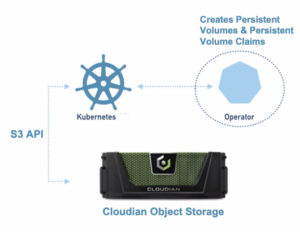
Cloudian Pins Container Hopes on K8s Operator

Object storage systems like Amazon S3 are currently winning the big data storage battle, thanks to low costs and infinite capacities. But getting object stores to work with containerized applications isn’t always straightforward. Now Cloudian, which provides on-prem object storage, is helping to simplify the integration with a Kubernetes operator.
A Kubernetes (or K8s) operator is a slim piece of software that allows customers to mount their storage system (whether it’s file-, block-, or object-based storage) to applications running in a K8s cluster, thereby enabling those application to use the storage system to store and persist the data.
Block storage arguably is the most popular way to store data from applications running under K8s at the moment. But the inherent limitations of block storage and the SAN devices that typically use it do not match up with emerging cloud application requirements, argues Jon Toor, the chief marketing officer for Cloudian.
“The reality is using Kubernetes just breaks a lot of the rules of how you use traditional SAN and NAS storage,” Toor tells Datanami. “If you’re using a cloud-like operating environment, which Kubernetes clearly is, whether you’re using it in the cloud or on prem, it makes sense to have a cloud-like storage platform.”
With the new K8s operator it unveiled last week, Cloudian is prepped to help its customers take the next step in supporting cloud-like applications. According to Sanjay Jagad, Cloudian’s senior director of products and solutions, the company’s new K8s operator lowers the barrier of entry for companies that want to pair enterprise object storage capabilities with Kubernetes in an easy-to-use manner.
“With our operator, you can now provision [storage] and access your Cloudian infrastructure or Cloudian object storage within the applications,” Jagad says. “So you can get the benefits of the underlying private cloud-like platform, because of the very nature that it’s scalable and it offers a lot of other valued features and functionality that are needed for the modern application.”
Currently, customers don’t have many choices when it comes to connecting object stores with K8s applications, according to Cloudian. Customers with large engineering teams can develop connectors, but they’re largely manual. Others use contain er storage interfaces (CSIs) that connect K8s with traditional block and file-level storage
er storage interfaces (CSIs) that connect K8s with traditional block and file-level storage
“What we see is yes, that [CSI method] is good to get started,” Jagad says. “But when we get our application into production, what we are looking for really is a lot more. We want a storage platform that scales. We want the security. We want the ability to have it be declarative through APIs. And that’s not what they’re getting today.”
If customers are in the cloud, object stores like Amazon Web Services’ S3 provide a native interface for K8s through their own K8s operators. But Cloudian’s customers typically do not want to run in the public cloud, or at least want to maintain some on-premise presence as part of a hybrid setup.
According to Toor, many of Cloudian’s customers aren’t necessarily ready to start using object storage with K8s applications, but they want to be ready when the time comes.
The customers are saying “I need to have a production environment that’s Kubernetes-ready,” Toor says. “We’re not seeing a lot of this on-prem yet…But a lot of our customer are lookig toward this as a future development that’s coming fast, and they want to be ready.”
To get existing applications to run in the modern cloud-like manner, they need to be containerzed using Docker and adapted to be managed under Kubernetes. That’s no small feat, and requires quite a bit of engineering. As Cloudian’s customers start rolling out contaizerd applicaiotns, Toor expects to see demand for the K8s operator increase.
“They have workloads they want to run today, right now, on object storage that don’t rely on Kubernetes,” Toor says. “But they want a system that they know is going to extend into that environment, so we’re essentially paving a path for them.”
Related Items:
Object Stores Starting to Look Like Databases
Cloudian Bolsters Object Store with Monitoring and Analytics
Cloudian Sees $94M for Object Funding



























